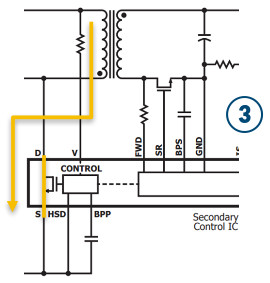
Called the InnoSwitch5-Pro family, they include 750V or 900V GaN power switches, and the company claims they can be used in converters with over 95% efficiency.
“The combination of ZVS and GaN is power supply magic – switching losses vanish,” claimed Power Integrations marketing manager Adnaan Lokhandwala. “For example, we have demonstrated 140W 28 USB PD adapters in 4.2in3 using 106 components.”

A subtle interplay between the secondary-side synchronous rectifier and the primary GaN switch is responsible for removing the need for an active clamp.
“Energy in secondary side used to prepare the primary switch for turn-on,” according to the company.
Before primary switching cycle occurs, the rectifier mosfet it turned on, transferring energy from the secondary to the transformer (diagram 1).
 When the rectifier is turned off, commutation keeps the inductor current flowing, and this current shifts charge stored in the capacitance of the (still-off) primary switch into the bulk input capacitor (diagram 2).
When the rectifier is turned off, commutation keeps the inductor current flowing, and this current shifts charge stored in the capacitance of the (still-off) primary switch into the bulk input capacitor (diagram 2).
Voltage across primary switch drops therefore drops, and the primary switch is turned on when it hits zero (diagram 3).
 There are two parts to the family:
There are two parts to the family:
- INN53xx optimised for universal AC inputs delivering 90 – 135W
- INN54xx optimised for 385Vdc operation following PFC stages delivering 105 – 220W
In each case, for a given IC, power will be at the lower end in enclosed power adapters and at the higher end in open-frame PSUs. Supplies designed for universal inputs will not deliver as much peak power as those designed for 230Vac (INN53xx) or 385dc (INN54xx) only inputs.
The majority of parts have 750V switches, with two 900V ICs (INN5396F INN5496) providing greater voltage leeway rather than extra power.
These devices, like the earlier 3-Pro and 4-Pro version, have an I2C bus on the secondary side, plus an auxiliary 3.6V output to power an I2C-enabled microcontroller for, for example, adjustable output USB PD adapters – “including designs that require the new USB PD EPR [extended power range] protocol”, said Power Integrations.
 Electronics Weekly Electronics Design & Components Tech News
Electronics Weekly Electronics Design & Components Tech News



